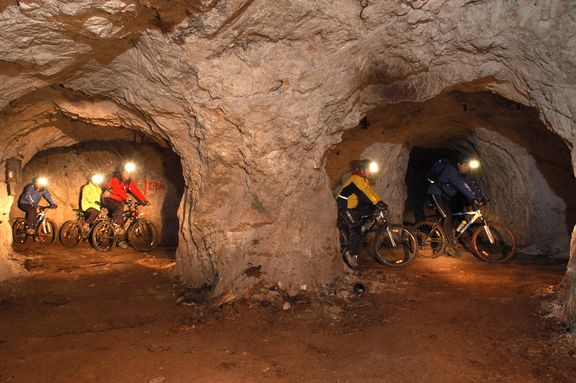Difference between revisions of "Podzemlje Pece, Tourist Mine and Museum"
(imported from XML by extractor/importer) |
m (Text replace - "{{Abstract" to "{{Teaser") |
||
| Line 16: | Line 16: | ||
| − | {{ | + | {{Teaser| |
Mining began in Mežica and the surrounding region in 1665. The establishment of the Kompoš-Brunner company in 1809 marked the start of the gradual transition to the industrial methods of obtaining ore, with mechanisation and the employment of an increasing number of workers. This is when the development of one of the largest lead and zinc mines in this part of Europe began. The ore deposits stretched across 64 kilometres; the shallowest shafts were located at 2,060 metres, and the deepest at 268 metres above sea level. During the long centuries of mining, the miners dug up 19 million tonnes of ore, acquiring one million tonnes of lead and half a million tonnes of zinc. 800 kilometres of tunnels had to be constructed for this. There were as many as 265 entrances into the mine. The gradual closure of the mine began in 1998 and was finally completed at the end of 2000. However, part of the mine - the Moring mining area and the 3.5 kilometre-long Glacnik tunnel which leads to it - has been preserved as a heritage site and museum.. A real miners' train takes visitors to the Moring mining area and the 15-minute journey is an incredible experience. | Mining began in Mežica and the surrounding region in 1665. The establishment of the Kompoš-Brunner company in 1809 marked the start of the gradual transition to the industrial methods of obtaining ore, with mechanisation and the employment of an increasing number of workers. This is when the development of one of the largest lead and zinc mines in this part of Europe began. The ore deposits stretched across 64 kilometres; the shallowest shafts were located at 2,060 metres, and the deepest at 268 metres above sea level. During the long centuries of mining, the miners dug up 19 million tonnes of ore, acquiring one million tonnes of lead and half a million tonnes of zinc. 800 kilometres of tunnels had to be constructed for this. There were as many as 265 entrances into the mine. The gradual closure of the mine began in 1998 and was finally completed at the end of 2000. However, part of the mine - the Moring mining area and the 3.5 kilometre-long Glacnik tunnel which leads to it - has been preserved as a heritage site and museum.. A real miners' train takes visitors to the Moring mining area and the 15-minute journey is an incredible experience. | ||
}} | }} | ||
Revision as of 18:04, 27 November 2009
The train stops in the centre of the Moring mining area, from where visitors can continue on foot with a guide. On a 1.5 kilometre-long path spiralling down between two horizons, the history of mining is presented to visitors. Mining equipment and a number of well-preserved machines are displayed on the very same spots where they were once used by the miners at work. Tunnels also used to be dug through the ore deposits, which is why there are still some remains of the glittering, grey coloured metallic lead ore.
The old mine administration building of 1927, located in front of the mine entrance, has been converted into a museum with a number of collections (a mining exhibition, the collection of Maks Kunc, miner and photographer).



